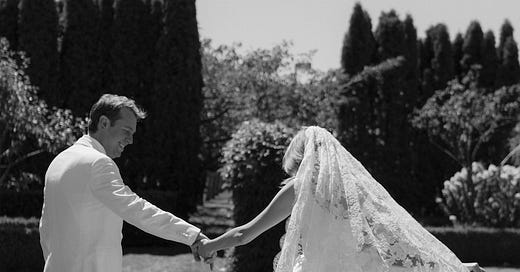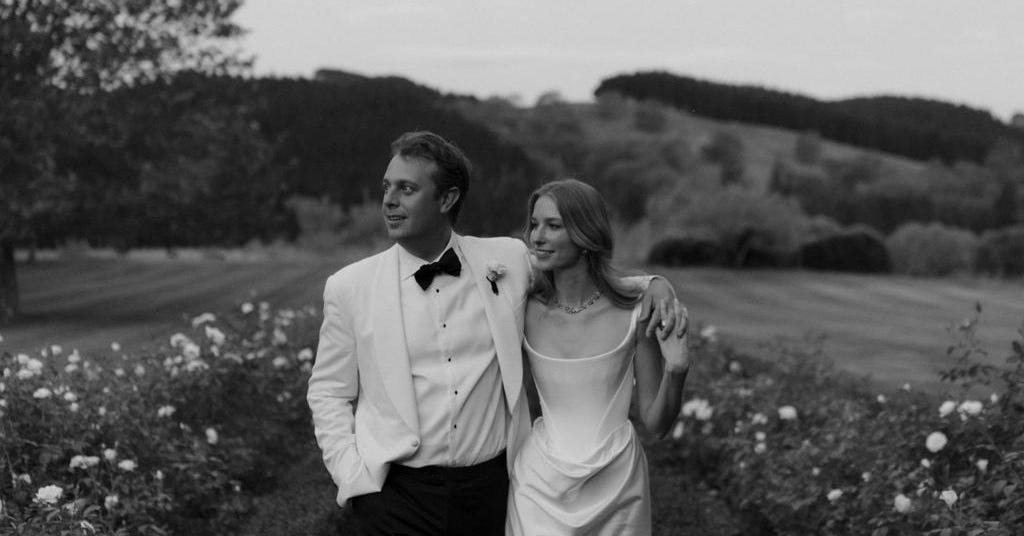When I walked down the aisle, I felt like I was floating – despite the weight of an all-over applique veil trailing behind me. It was an English cathedral-length, fit for an outdoor wedding in New Zealand summer. Coupled with a silk satin gown that hugged me before my husband could, it was the most surreal outfit I will ever wear.
This week, in the lead-up to our one-year anniversary, I shared our wedding story on The Kiwi Wedding Podcast. Back in the same beautiful surroundings where we said ‘I do’, I was reminded of how many intricate decisions made up the symbolic ocassion. On an day filled with superlatives, it was the little details that came to hold meaning, and now our memories.
One of the most important decisions, for me, was finding a white wedding dress. Knowing that I was following in the footsteps of so many brides drew me outside of myself, and I started to look further into this tradition.
As a symbol of virtue, I had assumed that white dresses had been worn at the very first weddings, but, in fact, it wasn’t until 1840 that Queen Victoria set the trend – in Spitalfields cream silk-satin with a flounce of Honiton lace, no less. While previous royal brides had worn a range of hues, a white gown was chosen to signify her innocence, and (ironically) it was also a sign of her wealth and power, as it was expensive to launder such an impractical colour.
Ivory dresses soon graced the aisle of Europe’s aristocratic weddings. Considering another important element of a society wedding – black and white photography – these dresses ensured the bride shone.
While most other women chose the nicest dress they owned for their wedding day, the first wedding gown was shown at a couture salon in 1924 by Jeanne Lanvin. She had lovingly designed the crepe silk frock for the marriage of her daughter, and no doubt wanted to show it off. Recalling ancient Roman wedding traditions, instead of Victorian, it was created in the colour of a golden flame.
It wasn’t until the post-war prosperity (and promotion of the ideal family) of the 1950s that more brides could invest in a special dress. Then, an interest in the weddings of Hollywood royalty, including Grace Kelly’s union with the Prince of Monaco in 1956, had many more vowing to wear white.
Her Serene Highness’ wedding dress, designed by Helen Rose, boasted a bodice of Brussels lace, a row of pearl-encrusted buttons and a tight-waisted taffeta skirt with flowing train. While Helen Rose was more costume designer than couturier (she met Grace Kelly at MGM), fashion editors took notes. From 1957, it was expected that an exceptional wedding gown would close a couture show in Paris.
Requiring a close relationship with the client, fine hand-detailing and an abundance of romantic references, the wedding gown is still a hero of couture collections. One of the most prominent fathers of contemporary fashion, Karl Lagerfeld, walked many famous ‘brides’ down his couture aisles. Created to wow audiences, these wedding gowns were a magnification, more than a reflection, of the bridal designs of their times.
In the ‘80s, such gowns were fabulously frothy, as another member of fashion royalty – Diana – wore a taffeta princess gown by David and Elizabeth Emanuel. Then, in the 90s, Claudia Schiffer closed couture Chanel shows on two separate occasions. Each dress continues to influence the culture – her basque-waist gown was worn by Dua Lipa to the Met Gala in 2023 and a modern mini was recreated by Sofia Richie for her much-followed French Riviera wedding that same year. Since the 2000s, Largefield’s creations became even more outrageous – and challenged ideas of what conventional wedding dress could be – including suits and swimsuits. This year, as the house awaits a return to relevance with its new creative director, Matthieu Blazy, the Chanel bride tried a little bit of everything at Haute Couture Week, from a bowed jacket and embellished belt to various tiered skirt and veil lengths.
Weddings are a time of transformation, and, in my experience, this materialises most in a bridal ensemble.
Couture Brides For All Seasons
The couture shows were in full swing this week. A stand-out from the calendar is Schiaparelli. Creative director Daniel Roseberry’s polished proposal led many to celebrate his pursuit of perfection, and others to bemoan the archaic contorting of women’s bodies, as gender politics seem to slip back in time, too. While couture bridal gowns often break with the reality faced by many reviewers in the front rows (those tucking their legs in for a profusion of tulle), they still influence the trends that emerge, on a slightly smaller scale, at Bridal Fashion Weeks (March/April) and, beyond this, at local bridal boutiques.
Jean Paul Gaultier –
Guest designer Ludovic de Saint Sernin ruffled some feathers in re-interpreting the house codes of Jean Paul Gaultier. However, the ethereal feathers of his bride make a compelling case for feather-light tulle and heavenly textures inspired by the natural world.
Giambattista Valli –
Red remains the traditional wedding dress colour in many Eastern cultures – a striking sign of passion and prosperity. Giambattista Valli’s bride was swept up in the drama with a full ball gown skirt and bow accents on the arms, which I expect will soon be added to the growing category of detachable bridal sleeves, including this year’s dreamy cloud sleeves.
Elie Saab –
Elie Saab is known for his glittering bridal gowns with floral applique techniques. The florals remind of Queen Victoria’s wedding dress decoration, but in a tonal blush colourway for brides who may not want a white dress, but still wish to look ethereal. The diaphanous veil with a more structured headpiece is a combination I expect to see in many wedding editorials, and real wedding moodboards.
Schiaparelli –
While Schiaparelli did not close its show with a ‘bride’, the whole presentation seemed angled for the wedding aisle, including dresses draped in pearls and barely-there layers of tulle. Look 3 seems to be the most shared, and its sweetheart neckline and rippling peplum (in cream stretch satin) will likely filter through in a more wearable fashion.
Wedding Links
The Kiwi Wedding Podcast –
If you are interested in hearing more about my husband Dan and I’s wedding, listen to the latest instalment of The Kiwi Wedding Podcast. Under the same banner, you can hear first-hand experiences from recent brides as well as industry experts in New Zealand.
Vogue Weddings –
Be a (digital) guest to the most romantic weddings around the world with Vogue Weddings. It was so special to share a little slice of our Hawke’s Bay wedding with the trans-Tasman team.
Viva Weddings –
As well as hosting a delightful range of real weddings (including yours truly’s), Viva pops the big questions, including the impact of the cost-of-living crisis and the evolution of etiquette, in the lead-up to such an emotional event.
We’re Better Together
Since it is the season of espousals, the next edition of For All Seasons is going head-over-heels for wedding culture. What would you like us to unveil?
The lines of communication are always open at For All Seasons.
Special requests can be registered via a direct message or our comment section.







